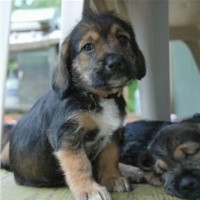Appearance of the Bowzer
|
| Very handsome and rather unique, the Bowzer resembles a Basset Hound with less extreme characteristics and a longer coat. They have retained the short limbs and long body of the Basset Hound, making them somewhat disproportionate to their Miniature Schnauzer relative. They have a flat forehead and a long muzzle that ends in a broad, black nose. Their eyes are generally dark brown and their ears are much shorter and thinner than those of the Basset. The Bowzer's coat is stiff and short to medium. Most will be a combination of colors with black and bronze or black and gray, these being the two most common examples. White patches are seen regularly. Some dogs of the breed have the long eyebrows and beard of the Schnauzer, not all. The Bowzer is a medium-sized dog that measures between 33 and 38 centimeters at the withers and weighs between 9 and 22 kilos when mature, making it considerably heavier than the Miniature Schnauzer. |
Temperament of the Bowzer
|
| Easy-going and attractive, Bowzers blend in well with most families and are pleasantly adaptable. They are affectionate with their owners and tolerant of children. Those who take more after the Miniature Schnauzer than the Basset Hound can be a little livelier and more territorial. The Bowzer's urge to hunt can remain high, even if it has never been exposed to hunting. This can make walking difficult in some areas, and make it impossible to house these guys alongside smaller pets, such as rabbits and guinea pigs. When it comes to living with larger animals, such as cats and dogs, they shouldn't have any problems as long as they're introduced at an early age. Unlike many other dogs, the Bowzer will not tend to suffer from separation anxiety. While we wouldn't suggest that an owner who's away all day should go out and buy a Bowzer, it's possible that a cat might be a more suitable pet. This may mean that owners have greater flexibility when planning their day, and don't need to have someone with the dog all the time. |
Needs and activities of the Bowzer
|
| Bowzers need daily exercise to stay fit and healthy. They can be hyperactive dogs and love to run. A trip to the beach or a wilderness area where dogs are allowed would be perfect. Make sure the dog is under voice control as they may be tempted to chase small animals. A house with a large enclosed yard would be ideal for your pet, but these can adapt to an apartment provided they are taken out at least twice a day for a fairly substantial workout. Bowzers are playful and enjoy chew toys to keep them stimulated and happy, and they also respond well to training. They have a moderate tolerance to heat and cold. |
Maintenance of the Bowzer
|
| Bowzers will need daily brushing to maintain their coat, as they tend to shed a lot. Brushing will also help remove loose hairs and eliminate knots and mats. This will depend on the composition of the parent breed, as Basset Hounds tend to shed much more than Miniature Schnauzers. Only bathe your pet when necessary, and use a dog shampoo to prevent skin irritation. Try to brush your pet's teeth regularly with canine toothpaste and clean the ears with soaked absorbent cotton. Nails should be trimmed if necessary, but always take care not to cut too close to the belly and cause bleeding. |









 English (United Kingdom)
English (United Kingdom)